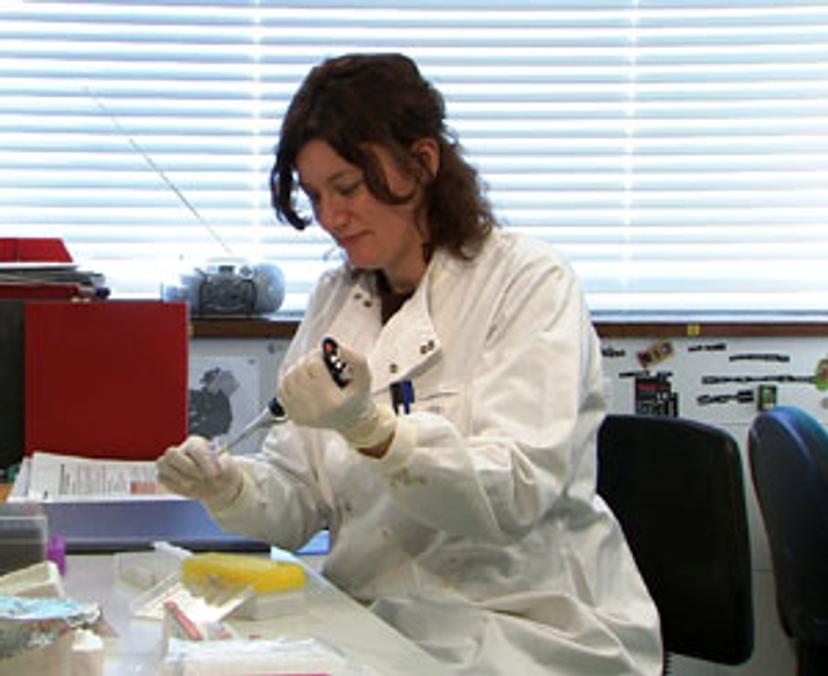The Science Behind the Identification of King Richard III
Hear how DNA analysis helped unravel the mystery
25 Mar 2015
Dr King working at the University of Leicester, UK Image: © University of Leicester
This is not a standard forensics case; ancient DNA is different from DNA you would find at a crime scene
Dr. Turi King University of Leicester
As King Richard III is finally laid to rest at Leicester Cathedral, UK, after his remains were discovered buried beneath a Leicester parking lot in 2012, we reveal how the scientists working on the project identified the king.
Studying History with Science
A series of rigorous scientific investigations carried out at the University of Leicester unanimously identified King Richard III, the last Plantagenet king who died in 1485, from remains discovered at the site of an ancient church, which is a parking lot today. The extended research team undertook a series of investigations, including: genealogy to identify living relatives of the deceased; DNA analysis to confirm a genetic match; psychology to re-assess Richard III's personality; osteology to understand the way in which Richard III lived and died; forensic analysis to assess his wounds and carbon dating to investigate the age of the skeletal remains.
We spoke to Dr Turi King, lecturer in Genetics and Archeology at the University of Leicester, who was responsible for the genetic identification of the skeleton. Dr King was initially invited to play a part in the project by Richard Buckley, University of Leicester Archaeological Services, because of her background in both archaeology and genetics. Dr King spoke of this being a "dream project", given her interest in using genetics to look at history, her main research focus for nearly 18 years.
The Science behind the Discovery
Dr King used standard DNA sequencing techniques to match the skeleton’s DNA with two relatives of Richard III on the maternal line.
The work required that the skeleton’s excavation was carried out following strict guidelines and under clean conditions to guarantee the sample’s integrity – not unlike forensic evidence collection. Dr King carried out the modern DNA analysis at the University of Leicester, while the ancient DNA analysis was performed at two dedicated ancient DNA facilities. Dr King carried out the ancient DNA analysis in the lab of Professor Michael Hofreiter with Gloria Gonzales Fortes at the Ancient DNA Facilities, University of York, UK. Working in sterile conditions, the excavated tooth was carefully cleaned and treated with UV light prior to crushing and extraction of the DNA. Mitochondrial DNA (mtDNA) was first used as opposed to nuclear DNA. One of the main reasons for this is that there can be several mitochondria per cell compared to only one nucleus, leading to a greater chance of recovering a workable amount of ancient DNA to analyze. This technique does incur limitations, as mtDNA is inherited maternally only direct relatives from the maternal line can be used as a comparison. This is where the genetic analysis tied in with another key area of the project, genealogy, and the participation of living relatives of Richard III from the maternal line.
Subsequently, the mtDNA was amplified using conventional PCR, whereby the DNA was subjected to thermal cycling to produce millions of copies of the DNA fragments. This method requires the use of a primer set, deoxynucleoside triphosphates and a DNA polymerase. Following this, the amplified DNA was sequenced using the Sanger method, in which the pattern of DNA bases was compared to that of the modern day maternal lineages. Results were then independently verified at the Université Paul Sabatier in France with Dr Patricia Balaresque and Dr Laure Tonasso. Verification of the results confirmed the DNA analysis corroborates with the archeological findings, taken together, this concluded that the remains belong to King Richard III.
An Ancient Forensics Investigation
The Richard III project has an element of modern forensics, in respect to the identification of unearthed remains and the victim’s possible death from two injuries to the skull during the 1485 Battle of Bosworth. Dr King said: “Although similar, this is not a standard forensics case; ancient DNA is different from DNA you would find at a crime scene because of its age. There are certain degradation patterns in ancient DNA, whereby if you know how degradation occurs you can take this into consideration when analyzing the DNA.”
Immense Public Interest
With the extreme amount of interest in this project, Dr King is keen to avoid ‘sensational’ science. King went on to say that as the remains happened to be from a “chap who turned out to be quite famous” which sparked immediate press interest, she admitted that this did cause considerable pressure to complete the DNA analysis in a certain time frame. Dr King modestly spoke about the science reaching the broader audience saying: “The public have known about Neanderthal ancient DNA work that has been done, so this project is fairly recent with a 500 year old subject.” In relative terms, this is quite a recent specimen but never the less the scientific analysis has confirmed a significant historical discovery.
This project has reached a global audience with interested individuals getting in contact from all over the world. Dr King said: “The biggest thing to deal with at the moment is all the emails from people who believe they may be descendents of Richard III and who wish to be tested.” One individual offered to send their tooth for Dr King to extract DNA from – presumably one that had already been removed! Even with the sudden influx in emails and her busy schedule, Dr King finds the time to reply to every message.
Read more about Dr Turi King>>

